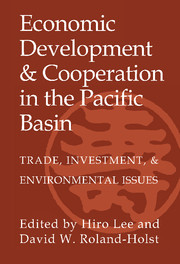 Economic Development and Cooperation in the Pacific Basin
Economic Development and Cooperation in the Pacific Basin Published online by Cambridge University Press: 19 May 2010
INTRODUCTION
The primary strategic challenge for trade policymakers is managing a continuously shifting pattern of trading opportunities. Apart from notable exceptions such as GATT (General Agreement on Tariffs and Trade) and an increasing number of regional trade accords, most of this policy is formulated and implemented unilaterally and with narrowly defined national interests. In this chapter, we argue that there exist cooperative trade strategies that can serve the domestic political agendas of national policymakers and can facilitate, rather than impede, the evolution of a trading system based on efficient international resource allocation. A larger set of cooperative solutions for policymakers would do much to foster the continued growth of the world economy and world incomes.
Trade between the United States and Japan has evolved dramatically over the last three decades, growing from a trickle to one of the world's largest bilateral trade flows. During the same period, the roles of the two countries in the world economy have also changed as new patterns of comparative advantage have developed between them and their trading partners. The United States has maintained prominence as an agricultural exporter and expanded service exports as a share of its total trade, but its leadership in a variety of manufacturing exports has been lost or seriously challenged as East Asian economies have aggressively developed new market niches in textiles, metal products, and consumer electronics.
Meanwhile, the Japanese economy experienced an unprecedented period of economic growth during 1955–73 and strong sustained growth during 1976–90, followed by a recession and slow recovery during 1992–97. The robust expansion of Japanese exports during 1955–90 was accompanied by extensive shifts in its underlying composition.
To save this book to your Kindle, first ensure no-reply@cambridge.org is added to your Approved Personal Document E-mail List under your Personal Document Settings on the Manage Your Content and Devices page of your Amazon account. Then enter the ‘name’ part of your Kindle email address below. Find out more about saving to your Kindle.
Note you can select to save to either the @free.kindle.com or @kindle.com variations. ‘@free.kindle.com’ emails are free but can only be saved to your device when it is connected to wi-fi. ‘@kindle.com’ emails can be delivered even when you are not connected to wi-fi, but note that service fees apply.
Find out more about the Kindle Personal Document Service.
To save content items to your account, please confirm that you agree to abide by our usage policies. If this is the first time you use this feature, you will be asked to authorise Cambridge Core to connect with your account. Find out more about saving content to Dropbox.
To save content items to your account, please confirm that you agree to abide by our usage policies. If this is the first time you use this feature, you will be asked to authorise Cambridge Core to connect with your account. Find out more about saving content to Google Drive.